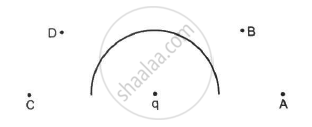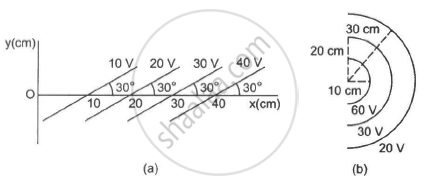Advertisements
Advertisements
प्रश्न
Two charged conducting spheres of radii a and b are connected to each other by a wire. Find the ratio of the electric fields at their surfaces.
उत्तर
Let a be the radius of a sphere A, QA be the charge on the sphere and CA be the capacitance of that sphere. Let b be the radius of a sphere B, QB be the charge on the sphere, and CB be the capacitance of that sphere. Since the two spheres are connected by a wire, their potential (V) will become equal. Let EA be the electric field of sphere A and EB by the electric field of sphere B. Then,
`E_A/E_B = ((Q_A)/(4piε_0a^2)) xx ((b^2 4piε_0)/(Q_B))`
`E_A/E_B = Q_A/Q_B xx b^2/a^2` ......................(i)
However, `Q_A/Q_B = (C_AV)/(C_BV)` .............(ii)
and `C_A/C_B = a/b` ...........(iii)
Putting the values of (ii) and (iii) in (i), we get,
`E_A/E_B = b/a`
Therefore, the required ratio of electric fields at the surface of the spheres is `b/a`.
APPEARS IN
संबंधित प्रश्न
(i) If two similar large plates, each of area A having surface charge densities +σ and –σ are separated by a distance d in air, find the expressions for
(a) field at points between the two plates and on outer side of the plates. Specify the direction of the field in each case.
(b) the potential difference between the plates.
(c) the capacitance of the capacitor so formed.
(ii) Two metallic spheres of Radii R and 2R are charged so that both of these have same surface charge density σ. If they are connected to each other with a conducting wire, inn which direction will the charge flow and why?
plot a graph showing the variation of current density (j) versus the electric field (E) for two conductors of different materials. What information from this plot regarding the properties of the conducting material, can be obtained which can be used to select suitable materials for use in making (i) standard resistance and (ii) connecting wires in electric circuits?
A charge Q is uniformly distributed over a large plastic plate. The electric field at a point P close to the centre of the plate is 10 V m−1. If the plastic plate is replaced by a copper plate of the same geometrical dimensions and carrying the same charge Q, the electric field at the point P will become
A metallic particle with no net charge is placed near a finite metal plate carrying a positive charge. The electric force on the particle will be
In the following figure shows a charge q placed at the centre of a hemisphere. A second charge Q is placed at one of the positions A, B, C and D. In which position(s) of this second charge, the flux of the electric field through the hemisphere remains unchanged?
(a) A
(b) B
(c) C
(d) D

A long cylindrical wire carries a positive charge of linear density 2.0 × 10-8 C m -1 An electron revolves around it in a circular path under the influence of the attractive electrostatic force. Find the kinetic energy of the electron. Note that it is independent of the radius.
A non-conducting sheet of large surface area and thickness d contains a uniform charge distribution of density ρ. Find the electric field at a point P inside the plate, at a distance x from the central plane. Draw a qualitative graph of E against x for 0 < x < d.
A block of mass containing a net positive charge q is placed on a smooth horizontal table which terminates in a vertical wall as shown in the figure. The distance of the block from the wall is d. A horizontal electric field E towards the right is switched on. Assuming elastic collisions (if any), find the time period of the resulting oscillatory motion. Is it a simple harmonic motion?

Some equipotential surface is shown in the figure. What can you say about the magnitude and the direction of the electric field?

